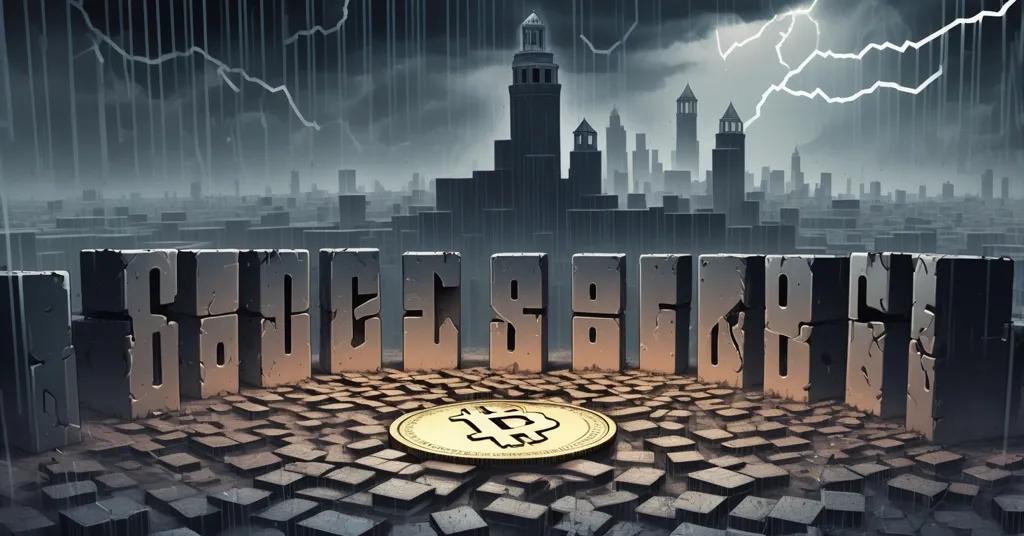Do Kwon Pleads Guilty in TerraUSD Collapse: 12-Year Sentence, $19M Fine—Justice Served?

Do Kwon Pleads Guilty in TerraUSD Collapse: 12-Year Sentence, $19M Fine—Justice for Investors?
Terraform Labs co-founder Do Kwon has officially pleaded guilty to two felony counts of wire fraud and conspiracy to defraud in a U.S. court in the Southern District of New York, a pivotal moment in the aftermath of the TerraUSD collapse in May 2022 that obliterated over $40 billion in investor wealth. With prosecutors recommending a 12-year prison sentence and a $19 million fine under a plea deal, sentencing set for December 11, 2025, and a massive $4.47 billion SEC settlement already in play, this case marks one of the biggest reckonings in crypto fraud history—but does it truly deliver justice to the countless Terra investors left in financial ruin?
- Guilty Admission: Do Kwon confesses to defrauding investors tied to the TerraUSD and Luna implosion.
- Plea Terms: A recommended 12-year sentence and $19M penalty, with final sentencing in December 2025.
- Investor Dilemma: Despite legal accountability, Terra victims may see little compensation for staggering losses.
The Rise and Catastrophic Fall of TerraUSD
For those new to the crypto space, TerraUSD (UST) was pitched as an algorithmic stablecoin—a digital currency meant to hold a steady $1 value not through cash or asset reserves like traditional stablecoins (think USDT or USDC), but via a complex balancing act with its sister token, Luna. Picture a seesaw: if UST dipped below $1, users could “burn” it to mint Luna at a fixed rate, and if UST rose above $1, Luna could be burned to create UST, theoretically stabilizing the price through supply and demand. It sounded innovative, even revolutionary, but in May 2022, this seesaw tipped into chaos. A liquidity pool attack on Curve-3pool on May 7 triggered mass panic, Luna’s value tanked under redemption pressure, and UST spiraled to near zero in a vicious “death spiral,” wiping out over $40 billion and sending shockwaves through the crypto market with bankruptcies and cascading failures. For a deeper dive into the mechanics of this failure, check out this detailed analysis of TerraUSD’s collapse mechanisms.
What made this collapse especially insidious was the hype machine behind it. Terra’s Anchor Protocol dangled a jaw-dropping 20% annual yield on UST deposits, sucking in 75% of its supply. But here’s the dirty secret: those returns weren’t backed by real profits—they relied on fresh deposits, echoing a Ponzi scheme’s playbook. When the market sneezed, this house of cards folded faster than a cheap tent in a hurricane. And at the center of it all was Do Kwon, once a darling of decentralized finance (DeFi), now a symbol of its darkest excesses. Learn more about his background and role in this fiasco on TerraUSD collapse Wikipedia page.
Kwon’s Confession: A Damning Indictment
In court, Kwon didn’t mince words about his role in the deception. His guilty plea to wire fraud—using electronic means to mislead people out of money—and conspiracy to defraud paints a grim picture of deliberate misconduct. As he admitted:
“Between 2018 and 2022 in the SDNY and elsewhere, I knowingly agreed to participate in a scheme to defraud purchasers of cryptocurrencies from my company, Terraform Labs.”
That’s not just a personal mea culpa; it’s a gut-punch to the trust many placed in Terra’s promises. Kwon even fessed up to a flimsy grasp of legal boundaries, saying, “I didn’t understand the details of international statutes… but yes, Your Honor,” when pressed on his awareness of wrongdoing. Judge Paul Engelmayer, who holds the gavel for the final sentencing, made it clear the decision is his alone, noting:
“It will be up to me to decide what a just sentence for you would be.”
The recommended 12-year term is a far cry from the potential 25-year maximum, and compared to Sam Bankman-Fried’s 25-year sentence for the FTX debacle in the same district, it raises eyebrows. Will Kwon’s plea deal soften the blow, or will the judge throw the book at him come 2025? That’s the million-dollar—or $40 billion—question. For more on the legal specifics, see the latest sentencing updates from the Southern District of New York.
A Legal Odyssey: From Montenegro to Manhattan
Kwon’s path to this courtroom was anything but straightforward. After Terra’s collapse, he dodged scrutiny until March 2023, when he was nabbed in Montenegro for using forged documents. Both the U.S. and South Korea—where Terra had a huge user base—fought to extradite him, but the U.S. won out, bringing him to American soil on December 31, 2024. Beyond the two felony counts he’s pleaded to, a broader nine-count criminal indictment looms, including securities fraud. Add to that a civil fraud verdict from the SEC in April 2024, which slapped Terraform Labs with a $4.47 billion settlement, effectively shuttering the company and funneling funds to creditors rather than regulators. Estimated payouts range from $184.5 million to $442.2 million, but for retail investors who lost life savings, that’s cold comfort—pennies on the dollar at best. Read more about the SEC settlement and investor restitution plans.
Digging into the dirt, the Department of Justice exposed Kwon’s underhanded tactics. Secret deals with trading firms to artificially prop up UST’s peg, false claims that Korean payments app Chai ran on Terra’s blockchain—these weren’t accidents. They were calculated lies, as U.S. Attorney Jay Clayton starkly put it, labeling this “one of the largest frauds in history.” It’s no wonder South Korea pushed so hard for extradition; reports suggest over 200,000 Korean investors were burned, a cultural and economic wound that still festers. For further details on the broader context of such cases, explore this overview of crypto frauds like TerraUSD.
But Is This Punishment Enough?
Let’s cut through the noise: a 12-year sentence and $19 million fine sound hefty, but stack that against $40 billion in vanished wealth, and it’s a slap on the wrist. The SEC’s $4.47 billion settlement looks better on paper, but with Terraform Labs in bankruptcy, individual investors are last in line behind creditors. Many who bought into UST’s “stable” promise—often everyday folks chasing a safe haven in a volatile market—are left with worthless tokens and shattered trust. Playing devil’s advocate, is 12 years enough when Sam Bankman-Fried got 25 for a similarly catastrophic fraud? Or does Kwon’s cooperation signal a judicial soft spot for crypto crooks who cut deals? With other cases like Roman Storm of Tornado Cash awaiting sentencing for related misconduct, the precedent here matters big time. For more insights on the legal outcome, check the report on Kwon’s guilty plea and sentencing.
Algorithmic Stablecoins: A Flawed Experiment?
Zooming out, Terra’s implosion isn’t a one-off—it’s a screaming warning about algorithmic stablecoins. History shows flops like Iron Finance in 2021 crumbling under the same “bank run” dynamics: when selling pressure hits, uncollateralized systems collapse like dominoes. Academic research calls out their “fragile foundation,” lacking the real-world transactions or intrinsic value that even shaky fiat currencies lean on during crises. Pre-collapse warnings from firms like SwissBorg in April 2022 flagged Terra’s exact vulnerability—a death spiral if Luna’s price couldn’t withstand UST redemptions. Yet the hype drowned out the red flags. There’s even murmur of a coordinated attack involving Bitcoin short-selling for profits upwards of $800 million, though hard evidence is thin. Whether manipulation or plain incompetence, the systemic risk is crystal clear. Curious about the root causes? This discussion on TerraUSD’s collapse reasons offers additional perspectives.
Contrast this with stablecoins like USDC, backed by actual dollar reserves and audited regularly. Terra had no such safety net, relying on faith in algorithms over hard assets. It’s a lesson in why untested mechanisms need brutal stress tests before billions are staked on them. Bitcoin maximalists might smirk—BTC’s fixed supply and pure decentralization dodge these gimmicks entirely—but let’s not pretend altcoins and other blockchains like Ethereum don’t have a role in pushing boundaries Bitcoin can’t or shouldn’t touch.
South Korea’s Unique Pain
Nowhere did Terra’s collapse hit harder than South Korea, where crypto adoption among retail investors was sky-high, fueled by cultural trust in tech innovation. Over 200,000 Koreans reportedly lost money, some their entire savings, drawn in by promises of stability and claims like Chai’s integration—later exposed as a sham. The economic toll was matched by public outrage, with South Korean authorities relentlessly pursuing Kwon’s extradition, seeing his actions as a betrayal of national trust. This wasn’t just a financial hit; it was a gut-wrenching blow to a community that embraced crypto as a path to empowerment. The government’s response, including delayed crypto taxes and tighter regulations, reflects a scramble to protect citizens from the next Terra, but the scars remain raw. Community reactions can be found on platforms like Reddit discussing Kwon’s guilty plea.
Regulatory Fallout: A Turning Point for DeFi?
Speaking of regulation, Terra’s disaster has lit a fire under global watchdogs. The SEC and DOJ’s hardline stance signals a future where algorithmic stablecoins might face demands for full asset backing or suffocating oversight. In the U.S., stablecoin legislation is gaining traction, while the EU’s MiCA framework aims to clamp down on uncollateralized designs. South Korea, stung by Terra’s impact, is doubling down on investor protections. But here’s the rub: overregulation risks strangling the freedom and disruption we hold dear in crypto. It’s a tightrope—how do we hold bad actors accountable without kneecapping DeFi’s potential? Community-driven standards, like open audits of code or transparent stress tests, might be a better path than top-down rules, preserving the ethos of effective accelerationism we champion. For specifics on regulatory actions, refer to the SEC’s settlement details with Terraform Labs.
Lessons for Bitcoin Maximalists and Altcoin Innovators
Let’s get real with the ideological split in our space. Bitcoin maximalists have every right to point at Terra and say, “Told you so.” BTC’s simplicity—no fancy algorithms, no pegs to prop up, just a hard-capped supply and unshakeable decentralization—makes it immune to this kind of meltdown. Terra’s failure reinforces why Bitcoin is the gold standard for financial sovereignty. But let’s not be dogmatic. Altcoins and protocols like Ethereum, with its smart contract muscle, or privacy coins like Monero, fill niches Bitcoin doesn’t serve. The catch? Experimentation must be responsible. Terra’s implosion isn’t a death sentence for innovation; it’s a call for rigor—audit your damn code, stress-test your systems, and don’t promise the moon unless you can deliver. We need both Bitcoin’s bedrock and altcoins’ ambition to drive this revolution forward, but never at the cost of investor trust.
Can Trust Be Rebuilt After Terra?
The human cost of Terra can’t be overstated. Beyond the billions lost, it’s the stories of regular people—retirees, students, small-time savers—who got burned chasing a “safe” investment. Recovery efforts through bankruptcy proceedings are a slog, and even with the SEC settlement, most retail investors won’t see meaningful restitution. Rebuilding trust in crypto isn’t just about nailing fraudsters like Kwon; it’s about creating systems that prioritize transparency over hype. Bitcoin remains the beacon of what decentralization can achieve, but the broader ecosystem must learn from Terra’s wreckage. If we’re serious about avoiding Terra 2.0, we need brutal honesty about risks, not pie-in-the-sky promises. Scammers and grifters, your days are numbered—and we’re damn glad to see the hammer fall.
Key Questions and Takeaways on the TerraUSD Collapse and Do Kwon’s Fate
- What triggered the TerraUSD and Luna collapse in May 2022?
A flawed algorithmic peg between TerraUSD and Luna, combined with a liquidity pool attack and market panic, led to a death spiral, erasing over $40 billion in value and triggering widespread crypto market chaos. - Does Do Kwon’s guilty plea bring justice to Terra investors?
It’s a step toward accountability with a recommended 12-year sentence and $19 million fine, plus a $4.47 billion SEC settlement, but retail investors are unlikely to recover significant losses given bankruptcy priorities. - How does Kwon’s case stack up against other crypto fraud convictions?
Compared to Sam Bankman-Fried’s 25-year sentence for FTX fraud, Kwon’s potential 12 years seems lighter, though the final ruling in December 2025 could shift based on the judge’s discretion. - What does Terra’s failure mean for algorithmic stablecoins and DeFi?
It exposes systemic flaws in uncollateralized designs, likely spurring regulatory demands for asset backing or oversight, while pushing DeFi to prioritize transparency to prevent future disasters. - Can the crypto industry regain trust after scandals like Terra?
Yes, through rigorous audits, honest risk disclosure, and community-driven standards, but repeated frauds mean prioritizing investor protection is non-negotiable—without killing the innovative spirit of decentralization.
As we await Kwon’s sentencing next year, the crypto world isn’t just watching one man’s fate—it’s grappling with what this signals for balancing innovation and accountability. Terra’s collapse is a brutal scar, but also a chance to forge tougher, smarter systems. Bitcoin stands tall as the unassailable core of decentralization, yet altcoins and protocols must carve their paths responsibly. Let’s push for effective acceleration by learning from this debacle, not repeating it. Will we spot the next Terra before it implodes, or will hype blind us again?



